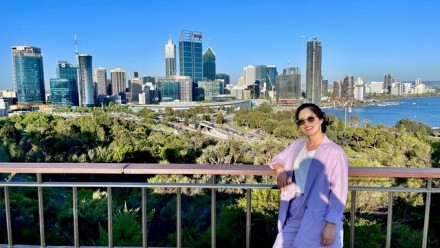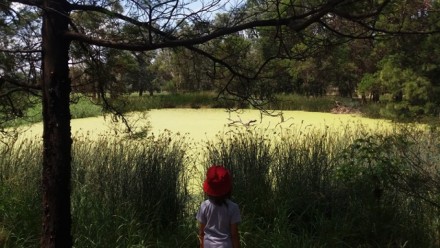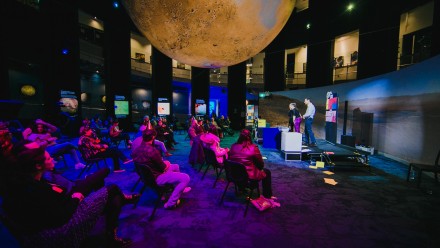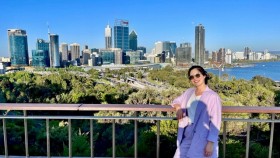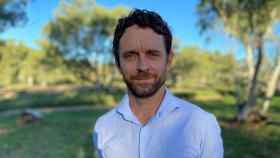Going viral with Questacon
Share
Partnering for powerful science communication
We’ve been bombarded with pandemic news and messaging for over a year. But have you ever wanted to meet the experts behind the headlines? Or dig a little deeper with a researcher – not an internet know-it-all?
The Population Health Exchange (PHXchange) partnered with Questacon to bring the science of pandemics directly from the College of Health and Medicine to the people. There are no Ivory Towers at Questacon, and our academics rolled up their sleeves to collaborate on innovative ways to communicate their research. We bet you’ve never been to a seminar on misinformation hosted by a Drag Queen, for example, but with the creativity of Questacon it was an obvious choice.
Dr Eryn Newman, memory and cognition expert, helped in the creation of a ‘Miss Information pageant’ (yes, it’s a double entendre) and penned scripts for pageant contestants to demonstrate four common types of misinformation tactics, i.e. cherry-picking, fake experts, conspiracy theories, and anecdotal evidence. The contestants then tried to convince the audience that their misinformation was the most insidious. These tactics were discussed and debunked by PhD students Mary Jiang and Deva Ly acting as contestant ‘judges’.
 Pageant host Toni Kola, and contestants Fay Kexperts, Annique Dotal, Cherri Pickken, and Con Spearitzy played by Centre for the Public Awareness of Science (ANU) students. Photo: Liz Drummond and Questacon
Pageant host Toni Kola, and contestants Fay Kexperts, Annique Dotal, Cherri Pickken, and Con Spearitzy played by Centre for the Public Awareness of Science (ANU) students. Photo: Liz Drummond and Questacon
With the audience safely inoculated against viral information, virologist Professor David Tscharke described how the AstraZeneca, Pfizer and Novavax COVID-19 vaccines work. Once again theatrics were embraced, with Tscharke comparing the functions of our cells to that of an office and office equipment. Questacon actors performed the ‘office work’ of vaccines, resulting in spike proteins that trigger our body’s defensive response against COVID-19. Audience members commented on how useful this analogy was in their understanding of how vaccines work. Epidemiologist Dr Meru Sheel continued this office themed discussion, describing the effect of vaccination on infection rates. Sheel explained how COVID-19 infection rates and proportion of hospitalisation change as vaccination rates increase.
 Professor David Tscharke and Dr Meru Sheel with ‘Microbial’ – an art installation raising awareness to the threat of antimicrobial resistance and superbugs, on loan to Questacon from the UN General Assembly. Photo: Liz Drummond
Professor David Tscharke and Dr Meru Sheel with ‘Microbial’ – an art installation raising awareness to the threat of antimicrobial resistance and superbugs, on loan to Questacon from the UN General Assembly. Photo: Liz Drummond
The final session saw an informal conversation about pandemics hosted by journalist Dan Bourchier, with epidemiologists Associate Professor Katie Glass and Associate Professor Lisa Whop. Artist Ali Wetherell from the PHXchange added some colour to the conversation through live scribing (cartooning). The discussion focussed on how communication and community are crucial in combatting COVID-19, and held up Aboriginal and Torres Strait Islander communities were celebrated as an example where leadership and trust have been successful. Audience members commented on how this narrative expanded their thinking on the path out of this COVID pandemic.
 Dan Bourchier chats with Associate Professor Katie Glass and Associate Professor Lisa Whop, while Ali Wetherell creates a visual art representation of their conversation. Photo: Questacon.
Dan Bourchier chats with Associate Professor Katie Glass and Associate Professor Lisa Whop, while Ali Wetherell creates a visual art representation of their conversation. Photo: Questacon.
While the audience enjoyed a fun, informative and high energy night (feedback has been overwhelmingly positive), they also contributed to research conducted by the PHXchange team aimed at improving science communication. To this end they participated in ‘straw polls’, mini experiments and surveys.
We are excited to have this opportunity to work directly with the public and Questacon. This collaboration is the beginning of an ongoing relationship between the College of Health and Medicine and Questacon, and builds on one already established between Questacon and the Centre for the Public Awareness of Science at ANU. We look forward to working closely with them in the future.
P.S. And what’s a Questacon event without liquid nitrogen icecream? We had that too…
 Questacon chefs cook up a delicious icecream Fizzer Spider (vaccine not included). Photo: Questacon
Questacon chefs cook up a delicious icecream Fizzer Spider (vaccine not included). Photo: Questacon
The following ANU staff and students helped make the night a huge success:
- The PHXchange team: Ali Wetherell, Dr Erin Walsh, Dr Ginny Sargent, Helen Skeat, Liz Drummond, and Toby James (Research School of Population Health)
- Vaccine discussion: Dr Meru Sheel (Research School of Population Health), and Professor David Tscharke (John Curtin School of Medical Research)
- Miss Information pageant: Dr Eryn Newman, Deva Ly, Mary Jiang (Research School of Psychology); Annie McDonald, Melissa Larkins, Mitchell Jeffrey, Amelia Pearson (Circus Scholars from the Centre for the Public Awareness of Science)
- Pandemic conversation: Associate Professor Katie Glass, and Associate Professor Lisa Whop, Ali Wetherell (Research School of Population Health)
- Contact tracing art installation: Jesse Newman and Professor Mitchell Whitelaw (School of Art and Design)
- Media and COVID-19 art installation: Dr Erin Walsh (Research School of Population Health); Dr Richard Terrett (College of Science)
- Additional research and event support: Dr Merryn McKinnon (Centre for the Public Awareness of Science), Amelia Yazidjoglou and Makayla Holz (Research School of Population Health), Kierra-Jade Maciver (College of Health and Medicine).
Special thanks to Questacon staff for their work leading up to the event and on the night, in particular Shannon Cook and David Cannell.
 Some of the ANU 'Questacon Goes Viral' team: (back L-R) Jesse Newman, Dr Richard Terrett, Dr Ginny Sargent, Ali Wetherell, Kiera-Jade Maciver, Professor Russell Gruen, (front L-R) Dr Merryn McKinnon, Dr Erin Walsh, Liz Drummond, Toby James.
Some of the ANU 'Questacon Goes Viral' team: (back L-R) Jesse Newman, Dr Richard Terrett, Dr Ginny Sargent, Ali Wetherell, Kiera-Jade Maciver, Professor Russell Gruen, (front L-R) Dr Merryn McKinnon, Dr Erin Walsh, Liz Drummond, Toby James.
By Liz Drummond.





